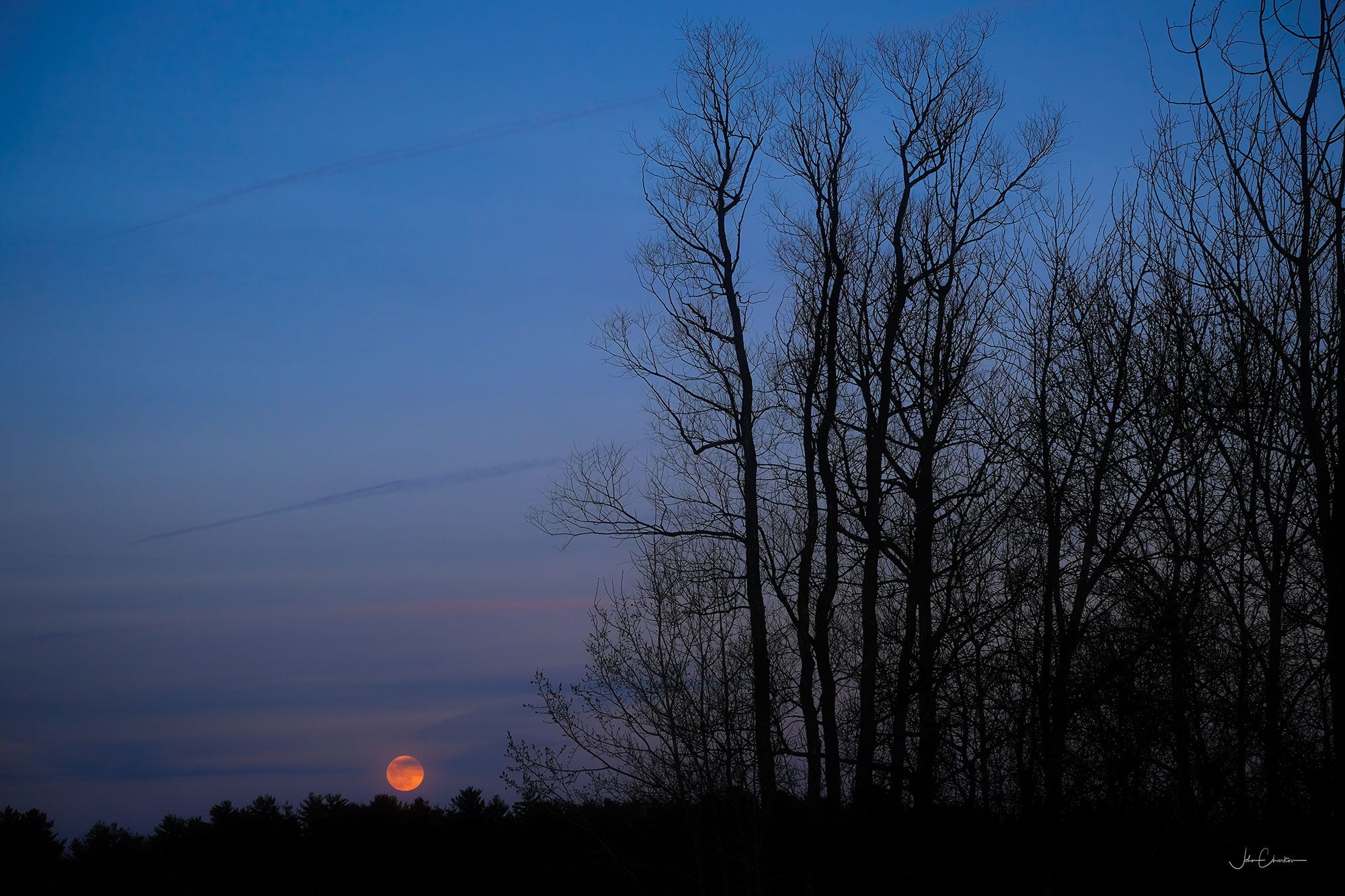Waiting patiently at dusk for the first sign of light to peak over the horizon, I checked the time once again. There is always a gap between moonrise and when it rises over the trees across the valley from us. I was in position when the classic moon rising over the horizon shot finally appeared.
I waited until the moon was sitting in the upper branches, cradled like a newborn in its mother’s arms before taking flight into the night sky. I made my move.
With my telephoto zoom held in the middle range, I shot a quick series of verticals to merge later into a panorama. It was really the only way to capture this rapidly fading transition from day to night.
The light was falling and the colours intense with a range of blue and purple tones in the sky above. The highest clouds caught the last warm rays of daylight rapidly disappearing in the west as the orange orb began its accent. Contrails from passing jets pin the top of the image. The forest below underlining the scene in inky black.
The low lying clouds began to obscure the moon. I grabbed another shot. With foreground lost to shadow, I walked back further into our yard to place the moon next to the strong verticals of our 5 willows. I Love the shape of them and they look awesome in silhouette. The contrails continue to work as a secondary visual element.
This was the image I was looking for. Something a little different. Something unique that tied the Sap Moon to the trees, their veins full of sweet nectar. Satisfied, I headed back in doors and settled with my evening coffee. But it seems I wasn’t finished.
As the moon rose higher, something drew me back outside for yet one more image. There’s something more here I thought. I just know it. The image of the willows was fresh in my mind. Good, but perhaps I could do better.
Returning to that same spot, I could see the light had changed. It was full on night now. Hard to make out any details in the sky. I placed the moon directly behind the willows hoping to work the scene again, knowing the more contrasty light required a different approach.
Already, I had pumped up the ISO to get anything close to a handheld shot. The more I raised the ISO, the more diffuse the light around the moon became. Now we’re talking. I pushed the ISO up higher. Up to the limit I had preset in the camera settings, cranking it all the way to 12,800. When I reviewed the shot, I was surprised how it didn’t look as noisy as I thought it would.
Running the image through Topaz Studio 2, I applied my ‘Beautiful Light’ custom filter which I have used so many times before to great effect. Presto, the noise was gone but the branches of the trees remained in sharp focus.
Why shoot the same thing over and over?
So the question arises, why shoot the same thing over and over? The answer is simple. Shooting over and over focuses the mind. It forces us to look deeper and to be more creative. And the proof is in the pudding.
The photo above was my last shot of the evening. It came as an unexpected bonus, much like the smokestack image from last month’s Snow Moon.
Until next time, John
POSTSCRIPT
I was at it again last night. Out waiting for the moon to rise. It does sometimes feel like an obsession. I found this Monet piece in the New Yorker this morning. Hilarious, and easily relatable. It’s an artistic mission. But perhaps you wouldn’t understand.
Claude Monet talks about about the mania of painting wheat stacks in his journal.
What I’m listening to








Loved the accompanying New Yorker article. Puts everything in perspective